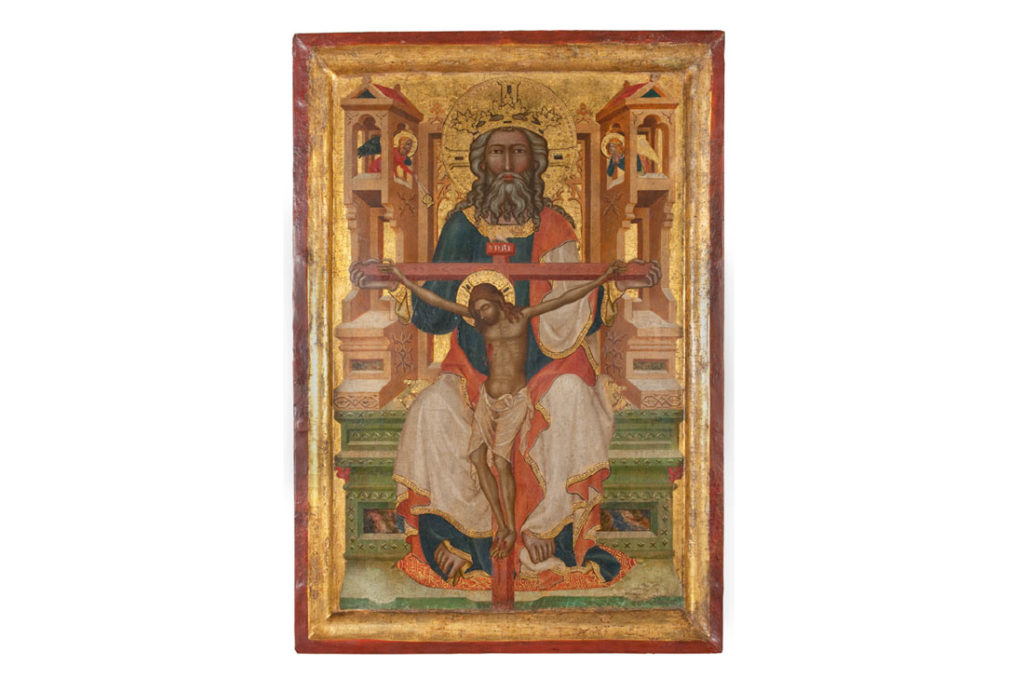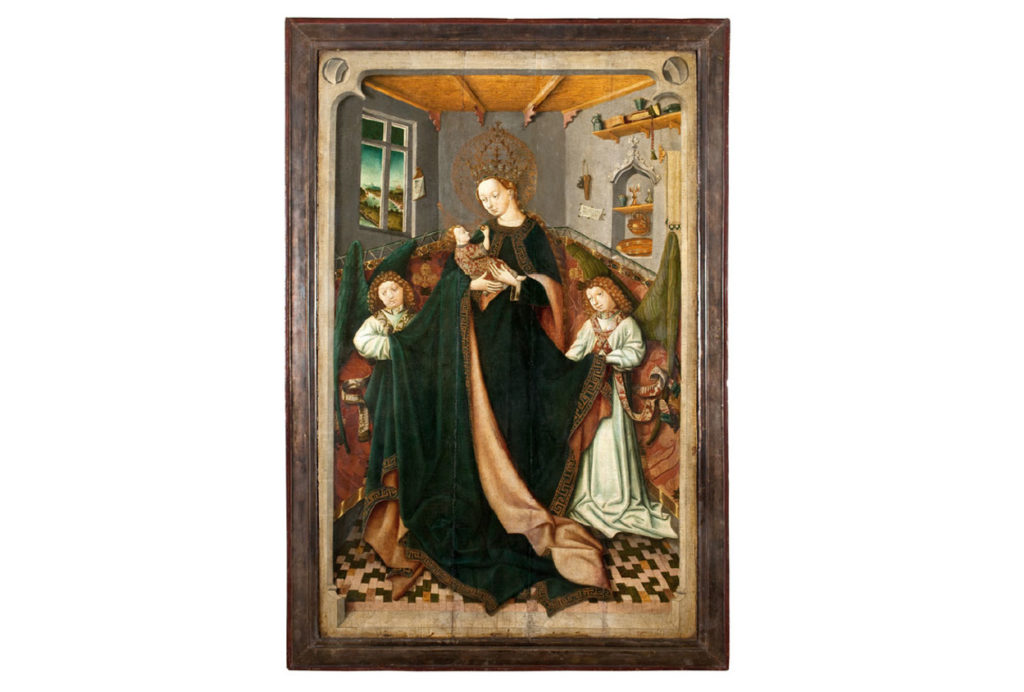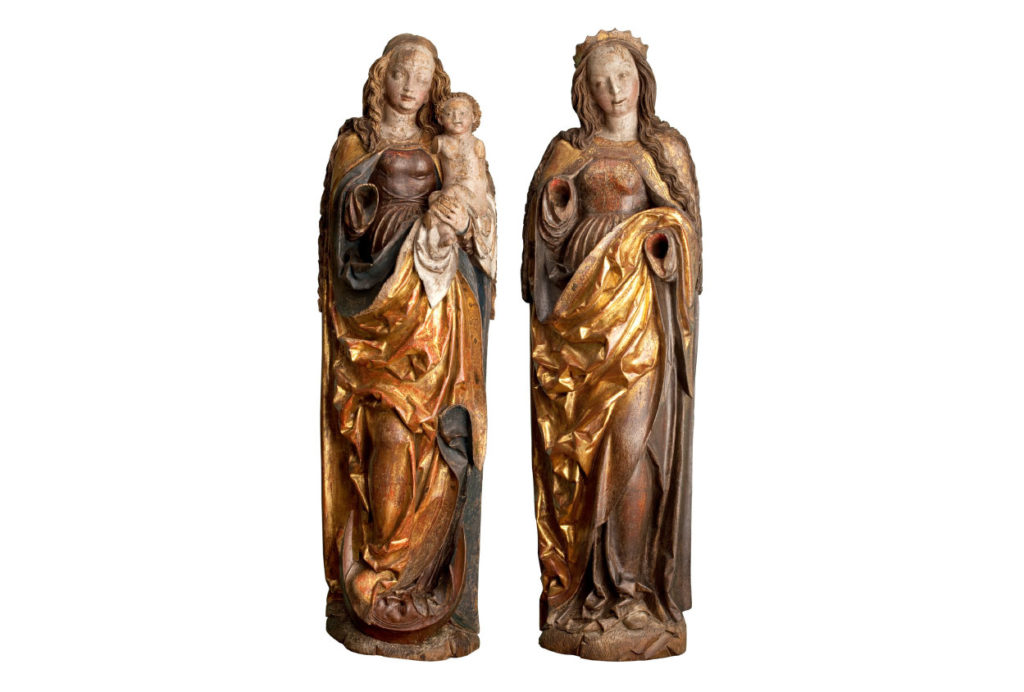The exhibition of Silesian art from the 14th–16th century presents visitors with a very rich and comprehensive selection of Gothic panel paintings and wooden sculpture, while examples of Gothic artistic crafts such as the very interesting collections of locks and keys, coins and seals can be viewed along the corridors.
The oldest picture in the gallery, The Throne of Grace from Świerzawa, was painted around 1350. It has been attributed to a painter from the workshop of the Assumption of the Virgin Mary in Košatki in Bohemia. This fairly small painting depicts the Holy Trinity in a way which is typical for the Middle Ages: God the Father is shown as the enthroned ruler who holds up the cross with the body of the Son of God sacrificed to redeem the sins of the world. A dove sitting on the plaque attached above Christ’s head represents the Holy Ghost. The picture clearly demonstrates the influence of Byzantine and Tuscan painting. It was discovered in 1898 in the attic of the rectory in Świerzawa near Złotoryja, however its actual origins still remain unclear.
Religious Gothic sculpture dating from the second half of the 14th century is represented in the gallery by the six figures of the Apostles and St Mary Magdalene. The sculptures were made in the Wrocław workshop of the Master of Figures of Apostles in the period of c.1360–1370, and are remarkable for their unnaturally elongated proportions and expressive faces. Originally the statues had been placed on the pillars in the main apse of the church of St Mary Magdalene in Wrocław, intended for viewing from below, hence their monumental and unnatural proportions.
One of the most charming works of art in this gallery is the small intimate painting of Madonna with the Child in Her Chamber, painted around 1450 in the studio linked to the work of the Master of the Wrocław polyptych of St Barbara. The figure of Mary with the baby Jesus features in the centre of the composition, flanked by two standing angels holding up her long cloak. Mary is depicted as Queen in an impressive lace-like crown entwined in her halo. Mary’s long hair is left loose as a symbol of her maiden state. The surrounding objects, characteristic for bourgeois interiors, are loaded with hidden meanings: books and writing utensils are the symbol of Mary’s wisdom, the glass and tin vessels on the shelves suggest Her being filled with God’s Grace. Next to them, a glass decanter with its top firmly closed, hints at her virginity. The painting demonstrates characteristic features of bourgeois realism linked to the painting from the Netherlands and the Upper Rhineland. It demonstrates an attempt at depicting the spaciousness of the chamber by the intuitive and still rather clumsy use of the principles of a convergent perspective.
The St Hedwig’s triptych , made in 1470-1480 for the church of St Elizabeth in Wrocław, provides an excellent example of a Gothic retable of a cabinet type. The Patron Saint of Silesia is placed in the centre of the middle panel and shown as the most important figure accompanied by St Sebaldus (to the left) and by an unidentified monk, probably St Vincent (to the right). St Hedwig holds in her hand a model of a church, representing the Basilica in Trzebnica founded by her. The side panels of the altar are decorated with the painted images of St John the Baptist, the patron Saint of Wrocław (to the left), and of St George, the patron Saint of Knights (to the right). The triptych has been attributed to the Master of the Altar of the Annunciation.
Among the other medieval retables on display, it is worth noting the altar cabinet from Domasław, containing three sculptures of exceptionally high level of artistry: Mary and the Child, St John the Baptist, and St Catherine. They were originally part of the altar made in 1519 in the workshop of the master marked as H.S., sometimes identified with Hans Schmyd in Wrocław. This work of art represents the already late phase of the Silesian Gothic. The gracefully charming figures of Mary and the two Saints are remarkable for the masterly carved folds of their robes.
The reliquary herm of St Dorothea, one of the most important artefacts, contains the relics of the Saint enclosed within an extremely valuable work of art. This extraordinary piece was made in the shape of a bust of a young woman with a rather severe face and a very prominent forehead, wearing an elaborate crown. The herm was made in the first quarter of the15th century from a partially gilded sheet of silver, and was initially kept in the old chapel of the Town Hall in Wrocław. It contained at that time a particularly valuable relic – St Dorothea’s scull, now stored in Wrocław Cathedral. Its top part has an aperture through which it was possible to view the relic without the need to remove it. Additionally, the base of the herm contained the relics of a few other Saints: Valentine, Martha, Thomas, Scholastica and Lawrence, described in writing on the attached pieces of parchment. They can be also viewed through the four glassed-over round apertures located in the base of the figure. The authenticity of the relics is visibly confirmed by the round seal of Pope Pius II ‘Agnus Dei’ placed on its right side. The Herm of St Dorothea is very ornate, decorated with precious stones, recognizable among them are mountain crystals, sapphires, emeralds and amethysts.
Following the Second World War the artefact was removed from Wrocław and incorporated into the collection of the National Museum in Warsaw. From 1987 the Herm of St Dorothea was displayed in Wrocław as a deposit, and finally in 2000 it was permanently returned to the National Museum in Wrocław where it is justly considered the star attraction in the collection of Gothic art, displayed on its own in the especially adapted room.



